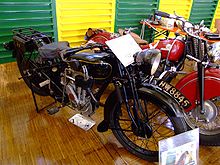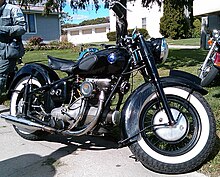Sunbeam Cycles
This article's lead section may be too short to adequately summarize the key points. (December 2010) |
This article includes a list of general references, but it lacks sufficient corresponding inline citations. (May 2010) |

Sunbeam was a British motorcycle marque.
History
Sunbeam was founded by John Marston, who was born in Ludlow, Shropshire, UK in 1836 of a minor landowning family. In 1851 at age 15, he was sent to Wolverhampton to be apprenticed to Edward Perry as a japanware manufacturer. At the age of 23 he left and set up his own japanning business, John Marston Ltd, making any and every sort of domestic article. He did so well that when Perry died in 1871, Marston took over his company and incorporated it in his own.
The company began making bicycles, and on the suggestion of his wife Ellen, Marston adopted the trademark brand "Sunbeam". Consequently, the Paul Street works were called "Sunbeamland". John Marston was a perfectionist, and this was reflected in the high build-quality of the Sunbeam bicycle, which had an enclosure around the drive chain in which an oil bath kept the chain lubricated and clean. They were made until 1936.
From 1903, John Marston Ltd had made some early experiments in adding engines to bicycles but they were unsuccessful, one man being killed. John Marston's aversion to motorcycles did not encourage further development, and so the Sunbeam Motor Car Company Ltd was founded in 1905. However, suffering from a slump which hit car making, Marston was pushed into making motorcycles from 1912 onwards (at the age of 76), for which there was a large and increasing market. Following in the tradition of their bicycles, the motorcycles were of high-quality, usually with a single cylinder, and known as the "Gentleman's Machine". Sunbeam motorcycles performed well in the early days of the famous TT (Tourist Trophy) races in the Isle of Man.
After the First World War, the Marston company was sold to a consortium. In 1919, the consortium became part of Nobel Industries Limited. In 1927 Nobel Industries amalgamated with Brunner Mond Ltd. to form Imperial Chemical Industries (ICI). In this huge organization motorcycles were a small part.
In 1937, the Sunbeam motorcycle trademark was sold to Associated Motor Cycles Ltd (AMC), which continued to make Sunbeam bicycles and motorcycles until 1939. AMC's core business was the manufacture of Matchless and AJS motorcycles. Some years after it sold Sunbeam, AMC went on to own Norton, James and Francis-Barnett.
In 1943, AMC sold the Sunbeam name to BSA, and Sunbeam Cycles Ltd came into being. Sunbeams were built not at BSA's main factory at Small Heath, Birmingham, but at another BSA factory in Redditch, Worcestershire. Three Sunbeam motorcycle models were produced from 1946 to 1956, inspired by BMW motorcycles supplied to the Wehrmacht during the Second World War. They were followed by two scooter models from 1959 to 1964.
Models
Sunbeam bicycles
Sunbeam bicycles (always "The Sunbeam") were made in Wolverhampton from 1887 to 1937. As the factory was used to sheet-metal working and japanning (the Victorian equivalent of today's oven-baked enamel or 'powder coating') the construction of cycles presented few problems. At first of similar design to other makers' machines, the company adopted a version of Harrison Carter's Little oil-bath chaincase in the mid-1890s. The cycle was re-designed so that the oil contained in the oilbath lubricated the bottom bracket, chain and rear hub, the only cycle so designed to date. The top model was the "Golden", with alloy wheel-rims, epicyclic two- and three-speed gears and real gold-leaf pin-striping. The "Royal" was of the same quality but had red lining and simpler equipment. These and other models were made at "Sunbeamland", Pool Street, Wolverhampton until 1937 and subsequently, to the same designs, by AMC and BSA until 1957.
Many John Marston Sunbeam motorcycle models were produced.The first was a 350 cc in 1912 followed by a range of 500 cc singles and some v-twins. In 1924, a new model numbering system was introduced; Sunbeam Models 1 through 11. Other higher numbered models were produced in later years. The majority had single cylinder engines developing relatively low power, though winning the TT races often, the last time in 1929. A hallmark of all Marston Sunbeams was the superb quality and finish in black with gold-leaf pinstriping.
S model motorcycles

The unusual S models were manufactured from 1946 to 1956. There were three: the S7, S8 and S7 Deluxe.
The engine layout was the unusual feature. The engine was a longitudinally-mounted inline vertical 500 cc twin which drove a shaft drive to the rear wheel. The inline engine made this technologically feasible—horizontally-opposed ("flat") twin engines on BMW motorcycles had already used shaft drives.
The original S7 was produced from 1946 to 1948 and did not sell well. In 1949, the sportier S8, with standard-sized wheels rather than the fat tyres of the S7, and BSA type front forks, was produced. The S7 design was improved and then sold as the S7 Deluxe.
The original S7 was available only in black, whereas the standard colours for the S8 were "Polychromatic Grey" or black. The S7 Deluxe came in either "Mist Green" or black. If sold abroad then BSA would supply the Sunbeam in almost any colour that BSA used.
Although the early S7 was not a good seller or mechanically very sound, it is the most sought after and commands a premium over the S7 Deluxe and the S8. When Sunbeam production came to an end, BSA sold the remaining stock of parts to Stewart Engineering. Bob and Chines Stewart were long time fans of the Sunbeam and for a time members of the Sunbeam Motorcycle Club. In 1963 they, along with other enthusiasts, broke away from the Sunbeam Motorcycle Club and formed the Sunbeam Owners Fellowship. David and Christine Holyoake now own and run Stewart Engineering out of premises in Leamington Spa, and are the sole supplier of spares for late-model Sunbeam motorcycles.
B model scooters
1959 to 1964
B1, B2 Scooters (see BSA Sunbeam).
References
- Champ, R.C. 1983. Sunbeam S7 & S8 Super Profile. Haynes Publishing Group, Yeovil. 56 pp.
- Champ, R.C. 1980. The Sunbeam Motorcycle. Haynes Publishing Group, Yeovil. 205pp.
- Champ, R.C. 1989. The Illustrated History of Sunbeam Cycles and Motorcycles. Haynes Publishing Group, Yeovil. 112pp.
- Haycraft, W.C. 1954. The Book of the Sunbeam S7 and S8. Sir Isaac Pitman and Sons, Bath. vii + 120 pp.
- Munro, D.W. 1954. Sunbeam Motor Cycles. Motorcycle Maintenance and Repair Series. C. Arthur Pearson Ltd., London. 138 pp.
